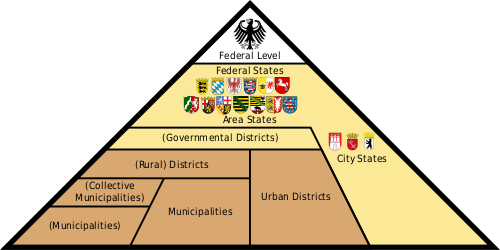Municipalities of Germany
Municipalities (German: Gemeinden, singular Gemeinde) are the lowest level of official territorial division in Germany. This is most commonly the third level of territorial division, ranking after the Land (state) and Kreis (district). A Gemeinde is one level lower in those states which also include Regierungsbezirke (singular: Regierungsbezirk) as an intermediate territorial division. The Gemeinde is one level higher if it is not part of a Samtgemeinde. Only 10 municipalities in Germany have fifth level administrative subdivisions and all of them are in Bavaria. The highest degree of autonomy may be found in the Gemeinden which are not part of a Kreis. These Gemeinden are referred to as Kreisfreie Städte or Stadtkreise, sometimes translated as having "city status". This can be the case even for small municipalities. However, many smaller municipalities have lost this city status in various administrative reforms in the last 40 years when they were incorporated into a Kreis. In some states they retained a higher measure of autonomy than the other municipalities of the Kreis (e.g. Große Kreisstadt). Municipalities titled Stadt (town or city) are urban municipalities while those titled Gemeinde are classified as rural municipalities.

Overview
 |
|---|
| This article is part of a series on the politics and government of Germany |
|
|
Head of State |
|
Executive
|
|
|
Administrative divisions
|
|
With more than 3,400,000 inhabitants, the most populated municipality of Germany is the city of Berlin; and the least populated is Gröde in Schleswig-Holstein. The cities of Aachen and Saarbrücken have a special status, which is why the numbers in the respective states North Rhine-Westphalia and Saarland appear in brackets in the table.
Municipalities per federal state
List updated on August 1, 2009.
| Federal state | Municipalities | Municipalities that are urban districts | Average no. of inhabitants[1] | Average area (km²)[2] | List (Cities, Towns, Municipalities) |
|---|---|---|---|---|---|
| Baden-Württemberg | 1,101 | 9 | 9,764 | 32.41 | C, T, M |
| Bavaria | 2,056 | 25 | 6,090 | 33.03 | C, T, M |
| Berlin | 1 | 1 | 3,416,255 | 891.02 | Berlin |
| Brandenburg | 419 | 4 | 6,052 | 70.36 | C, T, M |
| Bremen | 2 | 2 | 331,541 | 202.14 | Bremen, Bremerhaven |
| Hamburg | 1 | 1 | 1,770,629 | 755.16 | Hamburg |
| Hesse | 426 | 5 | 14,255 | 48.80 | C, T, M |
| Lower Saxony | 1,022 | 9 | 7,800 | 45.25 | C, T, M |
| Mecklenburg-Vorpommern | 818 | 2 | 2,053 | 28.34 | C, T, M |
| North Rhine-Westphalia | 396 | 22 (23) | 45,446 | 86.08 | C, T, M |
| Rhineland-Palatinate | 2,306 | 12 | 1,754 | 8.61 | C, T, M |
| Saarland | 52 | (1) | 19,935 | 49.40 | C, T, M |
| Saxony | 491 | 3 | 8,595 | 37.51 | C, T, M |
| Saxony-Anhalt | 851 | 3 | 2,835 | 24.03 | C, T, M |
| Schleswig-Holstein | 1,116 | 4 | 2,542 | 14.07 | C, T, M |
| Thuringia | 955 | 6 | 2,397 | 16.93 | C, T, M |
| Germany | 12,013 | 108 (110) | 6,844 | 29.35 | C, T, M |
See also
References
- Source: Statistisches Bundesamt (as of December 31, 2007)
- Source: Statistisches Bundesamt (as of December 31, 2006), excluding the municipality-free areas